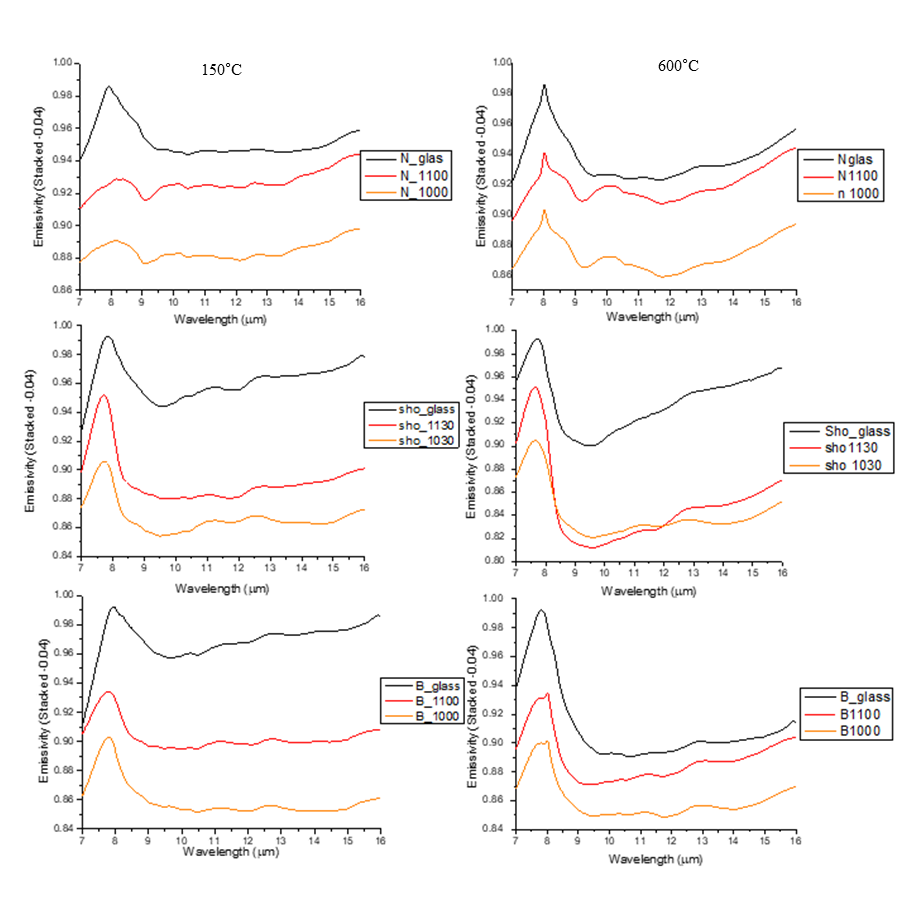Thermal-IR emissivity investigation on lab-made silicate rocks: implications for asteroidal and planetary studies.
- 1Università degli Studi di Perugia, Dipartimento di Fisica e Geologia, Perugia, Italy (alessandropisello@gmail.com)
- 2Institute for Planetary Research, DLR, Rutherfordstrasse 2, 12489 Berlin-Adlershof, Germany.
Abstract
Silicates are the main constituent of volcanic terrains on terrestrial planets and other rocky bodies in the solar system [1]. Typically, these volcanic terrains are constituted by fragmented pyroclasts whose texture is often afanitic or porphyric rather than holocrystalline: this means that the fraction of crystalline material is less relevant than the fraction of amorphous, or glassy, material. Thus, it is of paramount importance to take into account amorphous silicate phases to explore the influence of glass/crystal ratio on the spectral response of volcanic rocks, to better interpret available and future remotely sensed spectra from past and future missions [2, 3]. Here we report the results of a study concerning mafic volcanic products which were synthesized in order to present different degrees of crystallinity: three basaltic melts were cooled at different rates to obtain different textures, from totally amorphous to crystalline. Finally, they were analysed by means of emissivity in the thermal-IR range at different temperatures.
Samples preparation
Samples were produced by melting two natural mafic rocks: a basalt (low-alkali mafic rock from Snake River Plain, USA) and a shoshonite (high-alkali mafic from Vulcano island, Italy) following a two-steps routine of crushing and melting [4, 5]. A third silicate melt was produced by mixing and melting oxides to resemble the composition of Nakhlite meteorite [6]. The three melts were cooled in three different ways (Fig. 1) to obtain nine different samples. In order to obtain pure, crystal-free glasses, melts were directly quenched from super-liquidus temperature (Black line Fig.1), whereas other, identical, melts were cooled down slowly (52-56 °C per hour) and then quenched at subliquidus temperatures of ca. 1100°C (red line Fig. 1) and 1000°C (yellow line Fig.1). Following this approach, we obtained 9 rocky samples from three melts, so that each sample was differing in both chemical composition and crystallinity.
|
Figure 1: The three cooling ramps used for the syntheses of the material. |
Samples analysis
Samples were analysed using SEM, and spectroscopically characterized under different conditions: thermal-IR data have been acquired at the Planetary Spectroscopy Laboratory of the German Aerospace Center in Berlin (DLR), collecting the emitted thermal radiation for samples at different temperatures (150°C, 300°C, 450°C, 600°C; spectral range 5-16 μm) [7]. SEM imaging showed successful different degree of crystallinity for the three steps, which results in a different spectral response, visible in Figure 1.
By observing shape of spectra, crystalline Shoshonite and Basalt show similar shape to their relative amorphous but for a shoulder at 8.2-8.3 μm, whereas Nakhlite shows substantially different shapes for the three crystallinity steps (Fig. 2).
For what concerns the shift of the spectra, crystal-bearing products seem to show similar features at slightly lower wavelengths for Shoshonite and Basalt, whereas this trend is inverted for Nakhlite, probably due to different phases nucleating in different melts. Higher emissivity temperatures seem to homogenize the spectral response of samples with same chemical composition and different textural properties. These results provides further information on the spectral response of synthetised rock samples [2], that can be used for modeling of spectral information coming from rocky bodies in the Solar system

|
Figure 2: Spectra resulting from emissivity measurements performed on nine different products produced from three initial compositions (Nakhlite:N, Shoshonite:sho and Basalt:B). Emissivity was measured with samples at four different temperatures, two of which are here shown (150 and 600°C). |
References
[1] Namur, O. and Charlier, B. (2017). Silicate mineralogy at the surface of mercury.Nature Geoscience, 10(1):9.
[2] Pisello, A., Vetere, F. P., Bisolfati, M., Maturilli, A., Morgavi, D., Pauselli, C., ... & Perugini, D. (2019). Retrieving magma composition from TIR spectra: implications for terrestrial planets investigations. Scientific reports, 9(1), 1-13.
[3] Di Genova, D., Hess, K.-U., Chevrel, M. O., and Dingwell, D. B. (2016). Models for the estimation of fe3+/fetotratio in terrestrial and extraterrestrial alkali-and iron-rich silicate glasses using raman spectroscopy.
[4] Vetere, F., Iezzi, G., Behrens, H., Holtz, F., Ventura, G., Misiti, V., ... & Dietrich, M. (2015). Glass forming ability and crystallisation behaviour of sub-alkaline silicate melts. Earth-science reviews, 150, 25-44.
[5] Rossi, S., Petrelli, M., Morgavi, D., Vetere, F. P., Almeev, R. R., Astbury, R. L., & Perugini, D. (2019). Role of magma mixing in the pre-eruptive dynamics of the Aeolian Islands volcanoes (Southern Tyrrhenian Sea, Italy). Lithos, 324, 165-179.
[6] Treiman, A.H. (2005) The nakhlite meteorites: Augite-rich igneous rocks from Mars. Chemie der Erde 65, 203-270
[7] Maturilli, A., Helbert, J., Ferrari, S., Davidsson, B., and D’Amore, M. (2016). Characterization of asteroidanalogues by means of emission and reflectance spectroscopy in the 1-to 100-μm spectral range.Earth,Planets and Space, 68(1):113
How to cite: Pisello, A., Maturilli, A., Porreca, M., and Perugini, D.: Thermal-IR emissivity investigation on lab-made silicate rocks: implications for asteroidal and planetary studies. , European Planetary Science Congress 2021, online, 13–24 Sep 2021, EPSC2021-722, https://doi.org/10.5194/epsc2021-722, 2021.

